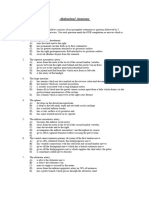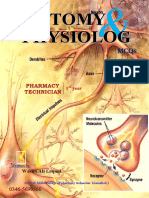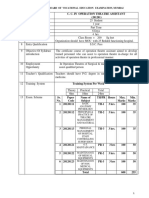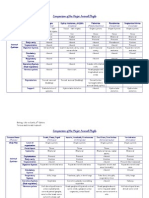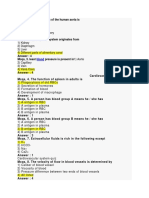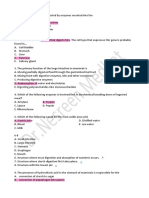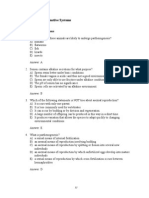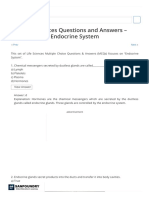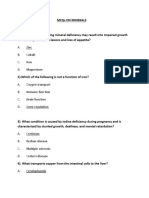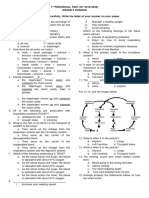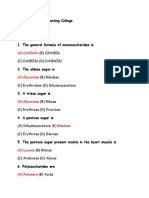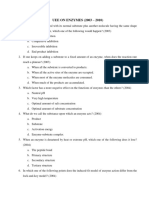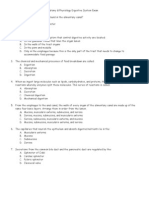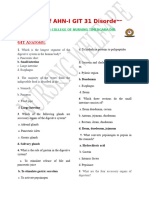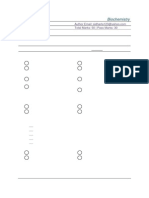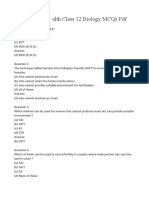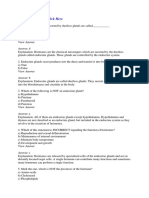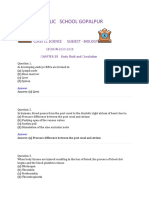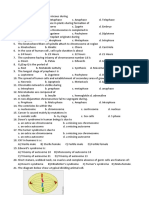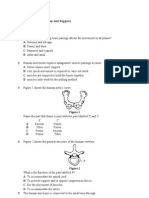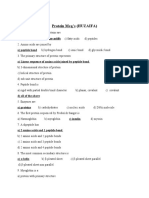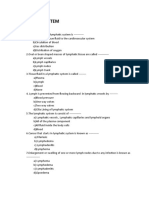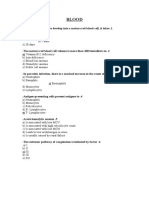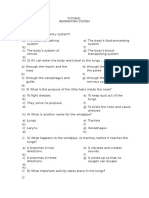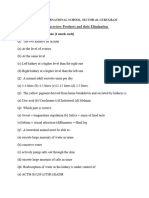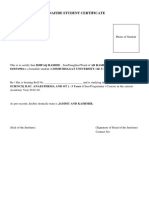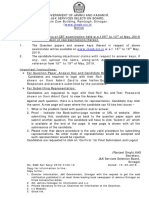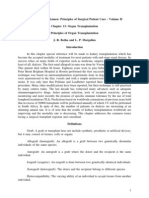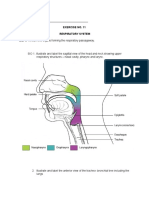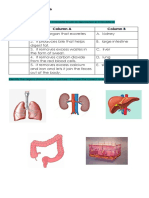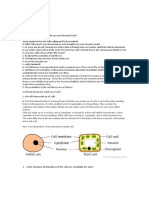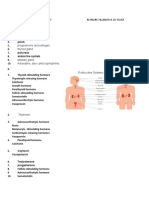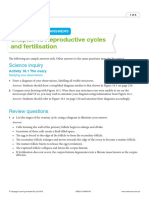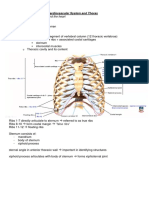Mcqs On Excretory System
Mcqs On Excretory System
Uploaded by
Ishfaq LoneCopyright:
Available Formats
Mcqs On Excretory System
Mcqs On Excretory System
Uploaded by
Ishfaq LoneOriginal Description:
Original Title
Copyright
Available Formats
Share this document
Did you find this document useful?
Is this content inappropriate?
Copyright:
Available Formats
Mcqs On Excretory System
Mcqs On Excretory System
Uploaded by
Ishfaq LoneCopyright:
Available Formats
MCQs on Excretory System
Excretory system in humans is specialized to carry out complex functions. It is formed by a pair of ureters,
kidneys, urethra and a urinary bladder each ultimately leading to excreting wastes out of the body. Excretion
is the phenomena wherein all the metabolic wastes are eliminated from the body.
1. This substance cannot pass through semipermeable walls of glomerulus
(a) Globin
(b) Albumin
(c) Blood cells
(d) All of the above
Answer: (d)
2. The reason why the right kidney is slightly lower than the left is
(a) the left kidney is bigger than right
(b) considerable space occupied by the heart
(c) considerable space occupied by the liver on the right side
(d) the right kidney is bigger than the left
Answer: (c)
3. Kidneys in the human body extend from this level
(a) 5th thoracic vertebrae to 3rd lumbar vertebrae
(b) 8th thoracic vertebrae to 12th lumbar vertebrae
(c) 10th thoracic vertebrae to 5th lumbar vertebrae
(d) 12th thoracic vertebrae to 3rd lumbar vertebrae
Answer: (d)
4. This pressure facilitates filtration while urine is being formed
(a) filtrate hydrostatic pressure
(b) osmotic blood pressure
(c) capillary hydrostatic pressure
(d) all of these
Answer: (a)
MCQs on Excretory System
5. This happens if the proximal convoluted tubule is removed from nephron
(a) urine is not formed
(b) quality and quantity of urine is unaffected
(c) urine is more concentrated
(d) urine is more diluted
Answer: (d)
6. This is the activity of Atrial Natriuretic peptide (ANP)
(a) inhibits aldosterone and ADH secretion
(b) decreases reabsorption of water
(c) decreases reabsoprtion of sodium
(d) all of these
Answer: (d)
7. The total number of orifices for outgoing and incoming of urine through the bladder is
(a) 2
(b) 3
(c) 4
(d) 5
Answer: (b)
8. Capillary hydrostatic pressure during filtration is built in the glomerulus as
(a) size of Bowman’s capsule is significantly large
(b) an afferent arteriole is narrow compared to efferent
(c) Bowman’s capsule is cup-shaped
(d) an efferent arteriole is narrow compared to afferent
Answer: (d)
MCQs on Excretory System
9. This artery passes blood to the kidney
(a) common iliac
(b) cystic
(c) renal
(d) coeliac
Answer: (c)
10. This is the functional unit of the kidney
(a) Hilum
(b) Neurons
(c) Nephrons
(d) Medulla
Answer: (c)
You might also like
- Reproductive SystemDocument5 pagesReproductive SystemHCX dghhq100% (2)
- Abdo & PelvisDocument15 pagesAbdo & PelvisAbid Khan100% (1)
- Anatomy & Physiology Mcqs Solved-1Document42 pagesAnatomy & Physiology Mcqs Solved-1Sana Rasheed100% (3)
- Mcqs AnatomyDocument2 pagesMcqs AnatomyArif Ali Rph83% (6)
- Medical Science MCQs Practice Test 1 PDFDocument3 pagesMedical Science MCQs Practice Test 1 PDFHazim Rhman AliNo ratings yet
- OT AssistantDocument9 pagesOT AssistantIshfaq Lone100% (1)
- Biology Comparison of The Major Animal Phyla ChartDocument2 pagesBiology Comparison of The Major Animal Phyla Chart09temp100% (3)
- Autopsy of Pazuzu AlgaradDocument7 pagesAutopsy of Pazuzu AlgaradFOX8100% (1)
- 11.0 Homeostasis - Longman MCQ QuestionsDocument12 pages11.0 Homeostasis - Longman MCQ QuestionsverysedatedxNo ratings yet
- Digestion 1 MCQDocument11 pagesDigestion 1 MCQgopod0% (1)
- Economic ZoologyDocument31 pagesEconomic ZoologyJohn StewartNo ratings yet
- Review Test - Blood and CV SystemDocument11 pagesReview Test - Blood and CV SystemMa Anna Cris LumongsudNo ratings yet
- A.2.4. Active Transport Systems MCQsDocument2 pagesA.2.4. Active Transport Systems MCQsPalanisamy SelvamaniNo ratings yet
- Digestive SystemDocument69 pagesDigestive SystemMostafa MontaserNo ratings yet
- McqsDocument5 pagesMcqsahsan gujjarNo ratings yet
- 2............. Human Anatomy and Physiology MCQDocument7 pages2............. Human Anatomy and Physiology MCQshahida hassanNo ratings yet
- Digestion 2 MCQDocument6 pagesDigestion 2 MCQgopod71% (7)
- Digestive + Respiratory HWDocument7 pagesDigestive + Respiratory HWlujainNo ratings yet
- Chapter 43 Reproductive Systems: Multiple Choice QuestionsDocument23 pagesChapter 43 Reproductive Systems: Multiple Choice QuestionsAnonymous Azxx3Kp9No ratings yet
- Digestion Test BiologyDocument3 pagesDigestion Test BiologyKatrīna SimanovskaNo ratings yet
- CH 2 MCQDocument24 pagesCH 2 MCQRamesh KulkarniNo ratings yet
- 2017 Functional Anatomy TestDocument10 pages2017 Functional Anatomy TestmarcusNo ratings yet
- The Digestive System MCQSDocument4 pagesThe Digestive System MCQSTahir AzizNo ratings yet
- Sense Organs Multiple Choice Questions and Answers - MCQ Objective QuizDocument5 pagesSense Organs Multiple Choice Questions and Answers - MCQ Objective QuizmanishjeswalNo ratings yet
- Cardiovascular SystemDocument9 pagesCardiovascular SystemShan ShaniNo ratings yet
- Endocrine System - Life Sciences Questions and Answers - SanfoundryDocument8 pagesEndocrine System - Life Sciences Questions and Answers - SanfoundryHUAWEI HUAWEINo ratings yet
- MINERALS MCQsDocument6 pagesMINERALS MCQsNasirNo ratings yet
- 1st Periodic Test - Science 9Document4 pages1st Periodic Test - Science 9Naylle Alivio100% (2)
- Membrane Potential MCQ-WPS OfficeDocument5 pagesMembrane Potential MCQ-WPS OfficeFavourNo ratings yet
- Pak International Nursing College Biochemistry MCQS: (A) Cnh2NonDocument19 pagesPak International Nursing College Biochemistry MCQS: (A) Cnh2NonShimmering MoonNo ratings yet
- 3-Enzymes (2003 - 2010)Document11 pages3-Enzymes (2003 - 2010)Asegedech BirhanuNo ratings yet
- Final McqsDocument119 pagesFinal McqsSajjad AhmadNo ratings yet
- AnatomyDocument4 pagesAnatomyFaisal AwanNo ratings yet
- MCQ Hap-II, Bp201tDocument39 pagesMCQ Hap-II, Bp201tANUJ DEVNo ratings yet
- CIRCULATION PHYSIOLOGY MCQs Test PDFDocument6 pagesCIRCULATION PHYSIOLOGY MCQs Test PDFMiles Hui67% (3)
- Digestive System Exam IIDocument13 pagesDigestive System Exam IIhugomiso100% (3)
- MCQs of AHN Unit-1 GIT 31 Disorders CompleteDocument36 pagesMCQs of AHN Unit-1 GIT 31 Disorders Completeloferk44No ratings yet
- MCQs in BiochemistryDocument7 pagesMCQs in Biochemistrysidharta_chatterjee50% (2)
- Proteins AnswersDocument2 pagesProteins AnswersBiancake Sta. AnaNo ratings yet
- G8 - 50 MCQsDocument10 pagesG8 - 50 MCQs胡哲菁No ratings yet
- Reproductive Health Class 12 Biology Mcqs PDF: Object 1Document41 pagesReproductive Health Class 12 Biology Mcqs PDF: Object 1rigNo ratings yet
- Chapter 42 Sample Questions and AnswersDocument3 pagesChapter 42 Sample Questions and AnswersLandry BrownNo ratings yet
- Tissue Exam QnsDocument4 pagesTissue Exam Qnsvarsha thakur100% (1)
- Hap-I Multiple Choice QuestionsDocument9 pagesHap-I Multiple Choice Questionsvaibhavi maliNo ratings yet
- MCQ On HormonesDocument3 pagesMCQ On HormonesShamla HarisNo ratings yet
- Chapter 18 Class 11 (MCQ)Document7 pagesChapter 18 Class 11 (MCQ)Ashok KumarNo ratings yet
- CELL CYCLE McqsDocument2 pagesCELL CYCLE McqsHamzullah Khan100% (1)
- Exercise On Locomotion and SupportDocument6 pagesExercise On Locomotion and SupportNorliyana Ali100% (1)
- Protein Mcq's (HUZAIFA) : B) Amino AcidsDocument4 pagesProtein Mcq's (HUZAIFA) : B) Amino AcidsHuzaifa Khaleeq100% (2)
- Physiology 3RD Test Steeplechase Revision 2023Document3 pagesPhysiology 3RD Test Steeplechase Revision 2023NewtonNo ratings yet
- Psychology & Sociology Ques BankDocument10 pagesPsychology & Sociology Ques BankSundar RajanNo ratings yet
- PG TRB Zoology Revision Test Unit I and XDocument12 pagesPG TRB Zoology Revision Test Unit I and XRoopa Roopavathy100% (2)
- Physiology McqsDocument5 pagesPhysiology McqsFaisal AwanNo ratings yet
- Lymphatic System MCQsDocument3 pagesLymphatic System MCQsNimra80% (10)
- Blood Physio McqsDocument23 pagesBlood Physio McqsTofik MohammedNo ratings yet
- Respiratory SystemDocument5 pagesRespiratory Systemshahirah77No ratings yet
- 185 Nervous System MCQs by Monsef - KarkorDocument60 pages185 Nervous System MCQs by Monsef - KarkorMostafa Montaser100% (5)
- 5 - Physiology MCQ Body Fluids & HormonesDocument5 pages5 - Physiology MCQ Body Fluids & Hormonesaboody omer100% (1)
- 120 MinutesDocument12 pages120 MinutesSooraj Matter LabNo ratings yet
- Solved Worksheet 1, THe Excretory SystemDocument5 pagesSolved Worksheet 1, THe Excretory Systemsinghriddhima67No ratings yet
- ExcretoryDocument7 pagesExcretoryakshitarao4960No ratings yet
- Bny Ahw 2406271907 0093120714 1Document7 pagesBny Ahw 2406271907 0093120714 1maheshshantagiri7090No ratings yet
- Kidney F Post TestDocument4 pagesKidney F Post TestMardie ArcesNo ratings yet
- StatisticsDocument167 pagesStatisticsIshfaq LoneNo ratings yet
- Bonafide PDFDocument1 pageBonafide PDFIshfaq Lone0% (1)
- MicrosoftDocument1 pageMicrosoftIshfaq LoneNo ratings yet
- Quotation For Books in Nursing CollegeDocument12 pagesQuotation For Books in Nursing CollegeIshfaq LoneNo ratings yet
- Application Proforma For Scholarship (Meritorious Student) : Annexure EDocument4 pagesApplication Proforma For Scholarship (Meritorious Student) : Annexure EIshfaq LoneNo ratings yet
- Biostatistics MCQS PDFDocument30 pagesBiostatistics MCQS PDFIshfaq LoneNo ratings yet
- Section One-Basic Sciences: Radhika Aggarwal MK Dey TK Datta G UshaDocument2 pagesSection One-Basic Sciences: Radhika Aggarwal MK Dey TK Datta G UshaIshfaq LoneNo ratings yet
- Mattox Trauma 8th Edition - PDF 2Document16 pagesMattox Trauma 8th Edition - PDF 2Meri YeghiazaryanNo ratings yet
- Bio Chapter 6 NoteDocument4 pagesBio Chapter 6 NoteZarir Abdul RashidNo ratings yet
- For Biology 250 at CSM: Compiled From Marieb's Human Anatomy & PhysiologyDocument26 pagesFor Biology 250 at CSM: Compiled From Marieb's Human Anatomy & PhysiologycathjoyceNo ratings yet
- Laboratory Test Report: Mrs. V Valli Kumari 81 Years FemaleDocument2 pagesLaboratory Test Report: Mrs. V Valli Kumari 81 Years Femaleuma100% (1)
- C. J. Mieny, U. Mennen: Principles of Surgical Patient Care - Volume II Chapter 13: Organ Transplantation Principles of Organ Transplantation J. R. Botha and L. P. MargoliusDocument28 pagesC. J. Mieny, U. Mennen: Principles of Surgical Patient Care - Volume II Chapter 13: Organ Transplantation Principles of Organ Transplantation J. R. Botha and L. P. MargoliusGordana UzelacNo ratings yet
- Week 11 Lab Exercise - Respiratory SystemDocument8 pagesWeek 11 Lab Exercise - Respiratory SystemJoselito JardielNo ratings yet
- Long Test 2 - Science 6: Match The Excretory Organs in COLUMN B With Its Description in COLUMN ADocument3 pagesLong Test 2 - Science 6: Match The Excretory Organs in COLUMN B With Its Description in COLUMN Akatherine corveraNo ratings yet
- Comic StripDocument2 pagesComic StripSatori TendōNo ratings yet
- Progesterone and Estrogen Thyroid GlandDocument3 pagesProgesterone and Estrogen Thyroid GlandReymark VillanuevaNo ratings yet
- Chapter 16 AnswersDocument6 pagesChapter 16 AnswersindapantsNo ratings yet
- Data KandeaDocument4 pagesData KandeaMuslim AmaluddinNo ratings yet
- Oral Mucous Membrane - Complete Denture PatientDocument84 pagesOral Mucous Membrane - Complete Denture PatientyabhatiaNo ratings yet
- Chabner: The Language of Medicine, 11 Edition: Answers To Pronunciation of Terms Chapter 4: PrefixesDocument3 pagesChabner: The Language of Medicine, 11 Edition: Answers To Pronunciation of Terms Chapter 4: PrefixesAhmed Hassan BullaleNo ratings yet
- Unit D - Human Systems Unit PlanDocument4 pagesUnit D - Human Systems Unit Planapi-427321002No ratings yet
- Gregorios-Histopathologic-Techniques Ch3 and 29Document78 pagesGregorios-Histopathologic-Techniques Ch3 and 29EllaineSonejaNo ratings yet
- DUHSReportDocument2 pagesDUHSReportFurqan SaleemNo ratings yet
- Stem Cell Therapy: Presented by DR - Ganga.T Jssmc. MysoreDocument42 pagesStem Cell Therapy: Presented by DR - Ganga.T Jssmc. MysorenilshrNo ratings yet
- Y7 - Cells Basic Labels With TaskDocument5 pagesY7 - Cells Basic Labels With Taskapi-3842747No ratings yet
- Archives of Pathology & Laboratory Medicine Online - Acute Leukemia Immunohistochemistry - A Systematic Diagnostic ApproachDocument13 pagesArchives of Pathology & Laboratory Medicine Online - Acute Leukemia Immunohistochemistry - A Systematic Diagnostic Approachpooo80No ratings yet
- Diagnostic Test in HematologyDocument18 pagesDiagnostic Test in HematologyJOHN ARBIE TATTAO, RN100% (7)
- Muscles Worksheet AnswersDocument2 pagesMuscles Worksheet Answerssamba50% (2)
- Dr. H.Yan Effendi Hasjim, DAHK 2018: Organ Sensoris Khusus Mata, TelingaDocument36 pagesDr. H.Yan Effendi Hasjim, DAHK 2018: Organ Sensoris Khusus Mata, TelingaharryNo ratings yet
- Genbio2 q2 Mod1.1 Reproduction-And-DevelopmentDocument9 pagesGenbio2 q2 Mod1.1 Reproduction-And-DevelopmentHazel AbitriaNo ratings yet
- Age Related Changes in Immunity Implications For Vaccination in The ElderlyDocument17 pagesAge Related Changes in Immunity Implications For Vaccination in The Elderlyrima nurmayasariNo ratings yet
- Anatomy of The CVS: ThoraxDocument10 pagesAnatomy of The CVS: ThoraxNayerShammaaNo ratings yet
- 04 Laboratory Manual Sbc3043 Semester 1, 2018 2019 A181Document19 pages04 Laboratory Manual Sbc3043 Semester 1, 2018 2019 A181Leena MuniandyNo ratings yet
- Leprosy: Pathogenesis Updated: ReviewDocument15 pagesLeprosy: Pathogenesis Updated: ReviewagneselimNo ratings yet
- Physiology of Body FluidsDocument23 pagesPhysiology of Body FluidsRamadan Physiology100% (2)

